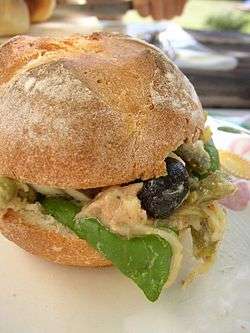Pan-bagnat
|
A pan bagnat sandwich | |
| Alternative names | Pain bagnat |
|---|---|
| Type | Sandwich |
| Place of origin | France |
| Region or state | Nice |
| Main ingredients | Pain de campagne or round white bread, Niçoise salad (radishes, tomatoes, pepper, onion, hard-boiled egg, olives, anchovies, olive oil) |
|
| |
The Pan bagnat (Occitan: pan banhat for wet bread, also spelled as pan bagnat or pan bagna, and alternatively in French as pain bagnat)[1][2][lower-alpha 1] is a sandwich that is a specialty of the Provence region of France.[2] It is also a specialty food and street food of Nice, France.[4] The sandwich is composed of pain de campagne, whole wheat bread formed in a circle, although white bread is also sometimes used, around the classic Salade Niçoise,[5] a salad composed mainly of raw vegetables, hard boiled eggs, anchovies and/or tuna, and olive oil (never mayonnaise). Sometimes balsamic vinegar, ground pepper, and salt will also be added. It has historically been prepared as a use for day-old bread.[2]
The pan bagnat is a popular dish in Provence[6] and the region around Nice[7] where it is sold in most bakeries and markets. Pan bagnat and the salade niçoise (salade nissarda), along with ratatouille (La Ratatouia Nissarda in Provençal), socca and pissaladière are strongly linked to the city of Nice, where they have been developed over time out of local ingredients. It is sometimes served as an hors d'oeuvre.[lower-alpha 1]
Etymology
The name of the sandwich comes from the local Provençal language, Nissart, in which pan banhat and the alternative spelling pan bagnat mean "bathed bread".[2] It is often misspelled "pain bagnat", with the French pain rather than genuine local pan.
Preparation
Pan bagna is prepared using bread or homemade bread (French: pain de ménage),[8] tuna steak or anchovies, sliced tomato, sliced olives, garlic and olive oil.[2][9] Additional ingredients to prepare the dish can include salt herring, goat cheese, arugula, basil, capers, gherkin, celery hearts, artichoke, mushrooms and lettuce.[9] and red wine vinegar.[2][9] Canned tuna is sometimes used in place of tuna steak.[2] The olive oil is typically used on the bread, which may be marinated or soaked in the oil and then strained off, hence the name "bathed bread".[lower-alpha 1][9] The garlic is sometimes used to rub the bread with.[9]
Similar dishes
Pan bagna is similar to the muffuletta sandwich.[2]
See also
Notes
References
- ↑ Golson, T.; Fink, B. (2006). The Farmstead Egg Cookbook. St. Martin's Press. p. 46. ISBN 978-0-312-35458-9. Retrieved May 27, 2016.
- 1 2 3 4 5 6 7 8 Hertzberg, J.; Franรงois, Z.; Gross, S.S. (2013). The New Artisan Bread in Five Minutes a Day: The Discovery That Revolutionizes Home Baking. St. Martin's Press. p. 101. ISBN 978-1-250-01828-1. Retrieved May 27, 2016.
- ↑ Wright, C. (2003). The Little Foods of the Mediterranean. Non Series. Harvard Common Press. p. 50. ISBN 978-1-55832-227-1. Retrieved May 27, 2016. (subscription required)
- ↑ Reichl, R.; Willoughby, J.; Stewart, Z.E. (2006). The Gourmet Cookbook: More Than 1000 Recipes. Houghton Mifflin. p. 186. ISBN 978-0-618-80692-8. Retrieved May 27, 2016.
- ↑ Arfin, F. (2011). Avignon, Nimes & St. Remy de Provence. Travel Adventures Series. Hunter Publishing, Incorporated. p. pt137. ISBN 978-1-58843-993-2. Retrieved May 27, 2016.
- ↑ Balcavage, D. (2009). Urban Vegan: 250 Simple, Sumptuous Recipes from Street Cart Favorites to Haute Cuisine. Globe Pequot Press. p. 45. ISBN 978-0-7627-5828-9. Retrieved May 27, 2016.
- ↑ Stowell, D.; Black, G. (2010). The Veganopolis Cookbook: A Manual for Great Vegan Cooking. Perseus Books Group. p. 125. ISBN 978-1-57284-674-6. Retrieved May 27, 2016.
- ↑ Sinclair, C.G. (1998). International Dictionary of Food and Cooking. Fitzroy Dearborn. p. 388. ISBN 978-1-57958-057-5. Retrieved May 27, 2016.
- 1 2 3 4 5 David, E.; O'Neill, M. (1955). Summer Cooking. New York Review Books classics. New York Review Books. pp. 32–33. ISBN 978-1-59017-004-5. Retrieved May 27, 2016.
External links
- Commune Libre du Pan Bagnat: Association pour la Défense et la Promotion de l'Appellation Pan Bagnat
- La recette officielle du Pan Bagnat de Nice (The official recipe for Nice "Pan Bagnat")
